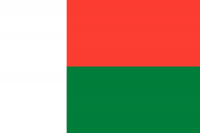Madagascar

The country of Madagascar is an island situated 400 km off the east coast of Africa, separated from the mainland by the Mozambique Channel. It is the fourth large island, stretching 1,580 km from north to south and 600 km from east to west, with a coastline of about 5,000 km. The topography is varied; hilly in the north and in the central part of the island (high plateaus with altitude between 1,200 and 1,500 metres) and plains in the east, west and south.
There are two major seasons in Madagascar. Summer is hot and rainy, and extends from October/November to March/April with temperatures ranging between 13 and 30 degrees Celsius. The winter season is cold and dry, from March/April to September/October, and has temperatures between 0 to 10 degrees Celsius.
The population of Madagascar is estimated at 20.696 million (latest census), and is divided into six provinces namely, Antananarivo, Antsiranana, Fianarantsoa, Mahajanga, Toamasina, and Toliary. French is the official language, while Malagasy is the national language. Madagascar became independent on 26 June, 1960. Antananarivo is both the administrative and commercial capital of the country; Fianarantsoa is another main centre providing for transportation of products to Tuléar in the southern part of the island. The president is the Head of State.
Agriculture contributes about 14 % of the GDP and within the agriculture sector, food producing cultivation constitutes 98 %, of which rice is 44 %, cassava and potato are 14% each, and maize is 9 %. Traditionally Madagascar is a producer of tea and coffee but with low market prices this industry has declined over the years. Madagascar is a key producer of fish, contributing sales of crabs, prawns, mussels and other seafood to the economy. Other contributors to the economy include industries focused on the areas of processing of meat and seafood, soap, brewery products, tanneries, sugar, textiles, glassware, cement, automobile assembly, paper and petroleum. Madagascar’s mineral potential is underexploited, yet it is perceived a key sector that can play an important role in the development of the country.
The main tourist attractions in Madagascar are Ambohimanga, Montagne d'Ambre National Park, Andasibe, Antsirabe, Isalo, Nosy Be, Nosy Boraha, Taolanaro, Taomasina and Toliary. The capital, Antananarivo, is a city built on a Y-shaped granite mountain surrounded by rice fields. Its main sights include the royal fort, which houses a historical museum of the ancient Malagasy kings and queens, Zoma the largest open air market in the world, and Tsimbazaza a botanical and zoological garden with various specimens of Malagasy flora and fauna. Madagascar is world famous for its natural beauty, richness in biodiversity and preserved cultural heritage. The country is home to 5 % of the world’s plant and animal species, 80 % of which are unique to Madagascar. Among its most notable examples of biodiversity are the lemur family of primates, three endemic bird families and its famous baobab trees.

